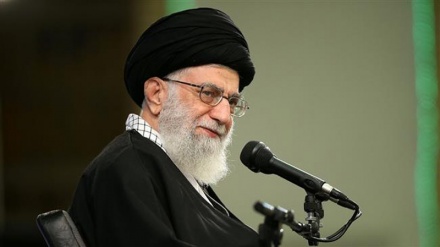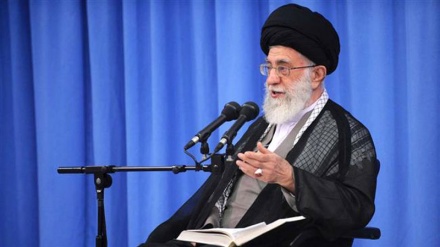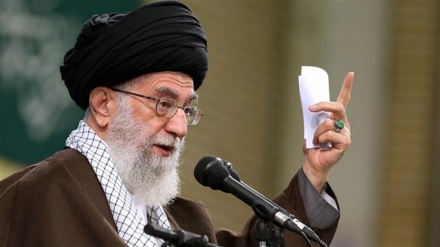In Presence of the Sun (100)
If you remember a couple of the past episodes, we have been dwelling upon the root causes of the Islamic Revolution with the elaborations of the Leader of Islamic Revolution, Ayatollah Khamenei on the issue.
Reza Khan and his son Mohammad Reza, through indifference toward the religious, social, cultural and economic demands of the Iranian people and imposition of a climate of repression, indeed accelerated their own collapse. Mohammad Reza Pahlavi, instead of relying on the people and enhancement of the country by the youths, would look up to the demands of the US. He never thought that his government would be obliterated by this very people. The suffocated cries of the Iranian nation were heard from the throat of Imam Khomeini and his wise guidance led to the collapse of the Shah and formation of the Islamic Revolution.
A brief review of the Iranian history makes it clear that the first flames of this unique phenomenon were kindled in 1962 and 1963. When Mohammad Reza, at the behest of his masters in Washington, proposed the law on the limitation and reform of landed property, it enraged the ulema as it was opposed to the Islamic rules and the dignity of women. At the helm of this widespread opposition was Imam Khomeini (God’s mercy upon him). According to this law Islam and the Qur’an were omitted as a condition for election of lawmakers. The law had also stipulated the suffrage of women.
A glance at the contents of the Shah’s law of reform indicates that he pursued several purposes from that law. First, he wanted to isolate the ulema and undermine their influence at the process of decision making. Secondly, with the omission of Islam as the official religion of the country and swearing by the Qur’an, non-Muslim groups would be granted full authority to enter the political scene and take the helms of the country’s administration. Thirdly, the Shah intended to raise the issue of freedom of women to attribute their backwardness and deprivation to Islam and the Constitution.
The controversial point of the law was the issue of women’s participation. As a matter of fact, both men and women were deprived of their primary rights during the Pahlavi era. The goal of the law was indeed to promote immorality and promiscuity among women. But the sage of the age, Imam Khomeini sharply detected the deceptive nature of the law, saying, “We are not opposed to the progress of women. We are opposed to immorality. We are opposed to these wrong deeds. Are men free let alone women?!! Can the freedom of man and woman materialize with mere words?”
Imam Khomeini, as the flag-bearer of opposition against this law, sent telegrams to the Shah and Premier Assad-ullah Alam and made consensus with the ulema for the rapid annulment of the law. Other Sources of Emulation of Qom, also, issued telegrams to oppose the anti-religious law. Thus, the people decided to show their protest via gathering at mosques. Fearing nationwide protests, the cabinet nullified the law and called it infeasible.
The annulment of the American-orchestrated law by the government set the ground for Iranian people’s uprising against the Shah under the leadership of Imam Khomeini (God’s mercy upon him). This was in fact a crushing blow to the regime and its master, the US. The enemy was determined to realize its agenda but it found the wakeful and vigilant ulema and the valiant people as the main bulwark ahead.
As the Nowruz or the new Iranian year was near, Imam Khomeini announced that the Iranian nation will not have a feast and will hold mourning ceremonies due to the harms afflicted by the US, Israel and the Pahlavi regime. The regime, however, ordered its agents to attack the famous Feizieh religious school in Qom and Talibieh religious school in Tabriz. These attacks claimed a large number of martyrs and injured. This measure of the regime proved its vassalage to Washington more than ever and showed that it was ready to sacrifice national interests to fulfill the demands of the enemy. But the great Leader of the Revolution addressing the nation, said, “Don’t be upset and worried. Don’t be distraught. Repel fear from yourselves. You follow the leaders who resisted against catastrophes and hardships. Our great leaders have gone through the events like Ashura and the eve of the 11th of Moharram and endured such calamities in the way of God. What are you saying today? What do you fear? Why are you distraught? It is a defect for those who claim to follow the Commander of the Faithful (Peace upon him) and Imam Hussein (Peace upon him) to be daunted before the disgraceful acts of the ruling system. The oppressive establishment, through this catastrophe, materialized its defeat and destruction. We triumphed.” These words both breathed a new spirit in the body of the combatant nation and seriously called the legitimacy of the regime into question.
In 1963, a couple of months after the bitter event of Feizieh seminary, the 15th of Khordad uprising took place which was an everlasting and effective move. It was the beginning of great developments. In the dawn of 15th of Khordad (June 5, 1963) the agents of the regime assaulted the plain house of Imam in Qom, arrested the Imam and transferred him to a prison in Tehran. As the news of the Imam’s arrest was released many of the people of Qom went to his home and around 6 a.m. they marched toward the holy shrine of Lady Ma’soumah (Peace upon her). Then the entire enclosure and the adjacent streets were filled with people who chanted “Either death or Khomeini”. At the same time many ulema and Sources of Emulation issued statements calling for the immediate release of Imam Khomeini. But the regime of Shah rejected these demands and replied the nationwide request with gunshot. Thus a big number of defenceless people were martyred.
Upon the release of the news of the regime’s savage attack on the people of Qom, people of Tehran and many other cities rushed to the streets to protest Imam Khomeini’s arrest and the regime’s atrocities. In one of the fateful events, the farmers and other people of Varamin in the southeast of Tehran marched toward Tehran while they had put on their shrouds. People from all walks of life joined the nationwide uprising chanting mottoes like, “Either death or Khomeini” and “Death to Shah”.
The regime of Mohammad Reza Pahlavi reacted the nationwide uprising with machineguns. In the cities of Mashhad, Tabriz, Shiraz and so on a lot of people were martyred by direct shooting of the agents of regime. What is interesting is that the news of Imam Khomeini’s imprisonment spread abroad and sparked the hatred and protest of other Muslims and freedom seekers. The Islamic seminaries of Najaf, Karbala and Kazemain in Iraq strongly supported Imam Khomeini and the sent telegrams to the heads of Islamic countries and international organizations in condemnation of the regime’s measure.
Ayatollah Seyyed Ali Khamenei says on the uprising of 15th of Khordad, 1342 (June 5, 1962) “15th of Khordad, 1342 is a very important juncture. The reason is that the event that occurred on the 15th of Khordad showed the bond of people with ulema at this dangerous and sensitive level. On the day of Ashura of that year- which corresponded with the 13th of Khordad- the great Imam delivered a historical and determining speech at Feizieh School. Later, when the Imam was arrested, on the day of 15th of Khordad, mainly in Tehran and Qom and some other cities, a huge wave of popular move took to the streets and the tyrant regime embarked on suppressing this popular move exerting its utmost, with its army, its police and its security apparatuses. On Khordad 15th a popular uprising took shape. This indicated that each and every Iranian has such a firm bond with ulema and the Sources of Emulation whose symbol was the great Imam. And the point here is that it is this very bond which guarantees the progress of the movement, culmination of the movement and victory of the movement. Wherever a move, a movement relies on people and people accompany it; this movement is capable of continuity. But if people do not join a protest move it will fail.”
RM/ME


